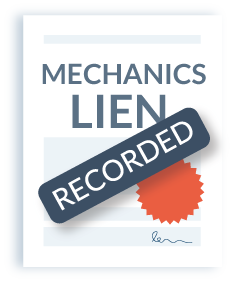None
Send a NoticeVermont Mechanics Lien FAQs
Quicklinks
“Levelset takes something that is pretty complex and makes it easy.”
Ready to file a lien in Vermont?
Not sure? Calculate your deadline for free.
Vermont lien law deadlines for:
Lien must be filed w/in 180 days from when payment became due for last materials or labor provided.
In Vermont, an action to enforce a mechanics lien must be initiated within 180 days of the date on which the Notice of Mechanics Lien was filed.
Additionally, within the same 180-day period, a prejudgment Writ of Attachment of the real estate must be obtained and recorded.
Note that one step alone is not sufficient, both steps are necessary. And, this deadline may not be extended. If the deadline is missed for one or both steps, the lien is unenforceable.
Lien must be filed w/in 180 days from when payment became due for last materials or labor provided.
In Vermont, an action to enforce a mechanics lien must be initiated within 180 days of the date on which the Notice of Mechanics Lien was filed.
Additionally, within the same 180-day period, a prejudgment Writ of Attachment of the real estate must be obtained and recorded.
Note that one step alone is not sufficient, both steps are necessary. And, this deadline may not be extended. If the deadline is missed for one or both steps, the lien is unenforceable.
Lien must be filed w/in 180 days from when payment became due for last materials or labor provided.
In Vermont, an action to enforce a mechanics lien must be initiated within 180 days of the date on which the Notice of Mechanics Lien was filed.
Additionally, within the same 180-day period, a prejudgment Writ of Attachment of the real estate must be obtained and recorded.
Note that one step alone is not sufficient, both steps are necessary. And, this deadline may not be extended. If the deadline is missed for one or both steps, the lien is unenforceable.
Vermont Mechanics Lien FAQs
Who can file a Vermont mechanics lien?
In Vermont, any party who furnishes labor or materials for the erecting, repairing, moving, or altering improvements to real property under contract with the property owner, owner’s agent, contractor or subcontractor of owner is entitled to mechanics lien rights. It appears that subcontractors and suppliers of any tier are allowed to claim a mechanics lien in Vermont. It is not clear whether design professionals are able to claim a lien in Vermont.
Is a written contract required to file a mechanics lien in Vermont?
Generally, a written contract isn’t required in Florida to be able to file a mechanics lien. However, its always a good idea to get a contract in writing at the outset of each and every construction project.
• Dive deeper: Can a Contractor File a Lien Without a Written Contract?
Can an unlicensed contractor file a Vermont mechanics lien?
Vermont imposes no specific licensing requirements for a party claiming a mechanics lien, but it is never a good idea to perform work for which a license is required without that license.
• Learn how to get licensed: Vermont Contractor Licensing | Guide to Rules and Requirements
When is the deadline to file a Vermont mechanics lien?
In Vermont, a Notice of Mechanics Lien must be filed no later than 180 days from the date on which payment became due for the last labor and/or materials furnished to the project.
It is not completely clear if this 180-day time limit is from the date on which payment is due to the claimant for his last furnishing of labor and/or materials, or the date payment is due to the last party to perform work and/or furnish materials to the project.
What information should be included in a Vermont mechanics lien?
The statute governing Vermont Notices of Mechanics Liens is not particularly clear regarding the information required on a lien. However, the following information should generally be included in every lien claim:
• Claimant’s information;
• Owner’s information;
• Lien amount;
• Description of labor and/or materials provided;
• Property description; &
• Date when payment became due.
→ Download a free Vermont Notice of Mechanics Lien form here
Does a Vermont mechanics lien need to include a legal property description?
No, other than the date the payment was due (if known), and the claimant’s signature, nothing is statutorily required to be included on a Vermont mechanics lien. Best practice is always to obtain a legal description, but it appears any description of the property is sufficient in Vermont. The more specific the description of the property, the less it is likely to be challenged.
• Learn more: Legal Property Description Search | A Complete Guide
Can attorney fees, collection costs, or other amounts be included in the lien amount?
No. Vermont does not allow for the inclusion of attorney’s fees or other consequential amounts in the lien amount. Interest and attorney fees may be awarded to the successful lien claimant in a foreclosure action at the discretion of the court.
Does a Vermont mechanics lien need to be notarized?
Yes. Vermont law requires that a mechanics lien must be notarized to be valid and accepted for recording.
• Learn more about notarizing construction payment documents
• Options for notarizing mechanics liens remotely
Where do I file and record a Vermont mechanics lien?
Vermont mechanics lien claims are documents recorded with the town clerk’s office. For your mechanics lien to be valid, you must record it in the town where the job is physically located.
Each office has their own unique rules and requirements. To help you, we’ve assembled all of the offices in Vermont that record mechanics liens. These pages will walk you through the county’s specific formatting requirements, deadlines, and fees.
• Be prepared: Essential Questions to Ask The County Recorder Before Filing a Lien
How do I actually file a Vermont mechanics lien?
There are a lot of questions on this page about who can file a Vermont mechanics lien, when it must be filed, what types of rules apply, and more. But you may be wondering something much more practical: how do I actually get my mechanics lien recorded and filed?
• For a full breakdown of the process, you may want to consult: How to File a Vermont Mechanics Lien | A Step-by-Step Guide
Do I need to send notice that the mechanics lien was recorded in Vermont?
There is no formal requirement that any notice be provided that the mechanics lien was recorded with the town clerk of the town in which the property was located. However, it may be best practice to send a copy of the lien to the property owner and general contractor (if applicable) in order to attempt to facilitate payment.
When is the deadline to enforce a Vermont mechanics lien, or, how long is my lien effective?
In Vermont, an action to enforce a mechanics lien must be initiated within 180 days of the date on which the Notice of Mechanics Lien was filed. Additionally, within the same 180-day period, a prejudgment Writ of Attachment of the real estate must be obtained and recorded. One step alone is not sufficient, both steps are necessary.
Can I collect the entire unpaid amount from the property owner if they already paid the general contractor in full in Vermont?
No, Vermont is considered an “unpaid balance lien state.” This means that a claimant may only recover the amount unpaid to the general contractor at the time the lien is filed; so for subcontractors and suppliers, time is of the essence in Vermont.
• Learn more: Full Price vs. Unpaid Balance Lien States
Does a Vermont lien have priority over pre-existing mortgages or other construction loans?
No. In Vermont, mechanics liens follow the general “first-in-time, first-in-right” rule. That is, any encumbrance recorded prior to the recording of the Notice of Mechanics Lien is superior to the mechanics lien, and the mechanics lien is superior to the encumbrances recorded after the recording of the Notice of Mechanics Lien.
• Dive deeper: Lien Priority- What Happens When Everyone Is Trying to Grab a Piece of the Same Pie?
Who cancels the Vermont mechanics lien if/when I get paid?
Vermont mechanics lien law does not specify who is required to have the lien released upon satisfaction. However, generally speaking, any payment to a lien claimant after a lien has been filed is made in consideration of, and contingent upon, the lien being released by the lien claimant.
People are asking Vermont construction attorneys:
Mechanic Leon
If a mechanics lien is issued and the debtor pays a partial payment does that release the lien
What does your services include for mechanic's lien?
what is the performance of a mechainic
Can a road association file a mechanics lien
Best rated general contractors in Vermont
5 essential things to know about Vermont mechanics liens
Contractors & suppliers have strong lien rights in Vermont. If a contractor or supplier isn’t paid on an Vermont job, they can turn to filing a lien to speed up payment and protect themselves. However, there are specific requirements and rules that must be followed. Here are 5 essential things you need to know about Vermont’s mechanics lien law.
There is no restriction on which tiers can file a Vermont mechanics lien
Vermont mechanics lien law allows broad protection regarding who can file a mechanics lien. The law includes any party who furnished labor or materials in the “erecting, moving, or altering improvements to real property under contract with the property owner, owner’s agent, contractor or subcontractor of owner.” There does not appear to be a limit on which tier of subcontractor can file a lien, but it is unclear on whether design professionals – such as architects and engineers – can file a lien.
The deadline to file a Vermont mechanics lien is a little bit unclear
The deadline to file a Vermont mechanics lien is a little unclear. It is stated that the deadline to file a lien is 180 days from the date on which payment became due and payable for the last furnishing of labor or materials. While it sounds fairly clear, there is some confusion over whether the 180 days starts from the date of which payment became due for the claimant’s last furnishing, or if the 180 days is calculated based on the date payment became due for the last party to furnish labor or materials to the project. While the deadline may be ambiguous, it may be considered best practice to file the lien within 180 days of the date payment became due for your last furnishing, rather than for the last furnishing of the project. This way, you are sure to be within the timeline of the project as a whole, and are not in danger of missing the period to file a valid lien.
No preliminary notice is required
It’s generally rare that no preliminary notice is required, but conveniently, that is the case in Vermont. Of course, a project participant can always send a purely informational preliminary notice, or a notice of intent to lien in an attempt to procure payment, and it may be a good idea to do so.
A Notice of Intent to Lien in Vermont may be enough to push for payment
A project participant's signature is required on a Vermont mechanics lien
Vermont technically requires very little information to be included on the face of the mechanics lien. The only information actually required by statute to be included on the lien is the date the payment became due and the claimant’s signature. While not required, it is best to include the legal property description or some other identification of the property, for indexing purposes. It is also a good idea to include a description of the work performed and the party for whom the work was performed.
Notice that the lien was recorded is not required
In Vermont, there is no requirement to send notice to anyone that the lien was recorded with the town clerk. However, it is generally advisable to send notice that the lien was recorded to the hiring party and property owner in order to facilitate a payment.
How to file a Mechanics Lien in Vermont (DIY)
Read the guide

In our step-by-step guide, we will walk you through each step required to qualify for and file a Vermont mechanics lien. This guide explains the notices you need to send, the information required on the Vermont mechanics lien form, and essential tips about delivering it to the county office for recording.
Get the right form

The next step is to download a Vermont claim of lien form. Our free, downloadable forms were written by construction attorneys to meet the strict requirements under Vermont mechanics lien law. The state statutes are very specific about the language and formatting required in a lien claim document. We make it easy to get this part right.
Fill out the form

This is the trickiest part of the process. Vermont is strict when it comes to the details and information required in mechanics lien claims, and making a mistake on the lien form could invalidate your claim. All of the information must be 100% accurate, including the legal names of each party, the property description, and the claim amount. Review every detail carefully.
File your lien with the registry of deeds

After you fill out your form correctly, it’s time to file your lien claim with the registry in the Vermont county where the property is located. Each county has its own fees and requirements, so view a full list of Vermont registry’s offices to find the contact information, fees, and filing requirements in your county.
Serve your lien on the owner

Although you’re not required to notify anyone on the project that you filed a mechanics lien in Vermont, it’s a good practice to send a copy of the lien to the owner or hiring party. This is because it improves transparency and often times facilitates payment.
Because it isn’t a requirement, there are no specific rules regarding how notice should be delivered.
After you file

Mechanics liens are valid for 180 days after filing in Vermont. Unless it is extended, you will need to enforce your lien claim within this deadline.
Vermont's Mechanics Lien Statutes
The provisions of the Vermont statutes that permit the filing of mechanics liens and materialman’s liens on construction projects can be found in Vermont’s Construction Lien Law, 9 V.S.A. § 1921 et. seq. The full text of the Vermont Construction Lien Law is provided below. Updated as of May 2023.
§ 1921. Extent of lien; notice
(a) When a contract or agreement is made, whether in writing or not, for erecting, repairing, moving, or altering improvements to real property or for furnishing labor or material therefor, the person proceeding in pursuance of such contract or agreement shall have a lien upon such improvements and the lot of land on which the same stand to secure the payment of the same.
(b) A person who by virtue of a contract or agreement, either in writing or parol, with an agent, contractor, or subcontractor of the owner thereof, performs labor or furnishes materials for erecting, repairing, moving, or altering such improvements shall have a lien, to secure the payment of the same upon such improvements and the lot of land upon which the same stand, by giving notice in writing to such owner or his or her agent having charge of such property that he or she shall claim a lien for labor or material. The notice shall include the date that payment is due, if known. Such lien shall extend to the portions of the contract price remaining unpaid at the time such notice is received.
(c) A lien herein provided for shall not continue in force for more than 180 days from the time when payment became due for the last of such labor performed or materials furnished unless a notice of such lien is filed in the office of the town clerk as hereinafter provided.
(d) A lien under this section shall not take precedence over a deed or other conveyance to the extent that consideration therefor has been paid in good faith before record of such lien. Such lien shall not take precedence over a mortgage given by the owner thereof upon such building, property, or improvements and the lot of land on which the same stand, as security for the payment of money loaned and to be used by such owner in payment of the expenses of the same, if such mortgage is recorded before such lien is filed in the office of the town clerk as hereinafter provided. If such mortgagee shall receive written notice that any lien hereunder is to be claimed, such lien shall take precedence over such mortgage as to all advances thereafter made under such mortgage to such mortgagor, except such advances as the mortgagee may show were actually expended in completing such improvements to real property.
(e) The lot of land covered by such lien shall be deemed to be all of the land owned or held by the owner and used or designed for use in connection with such improvements, but such lien shall not extend to other adjacent lands used for purposes of profit.
(f) A lien under this section may not be waived in advance of the time such labor is performed or materials are furnished, and any provision calling for such advance waiver shall not be enforceable.
§ 1922. Effect of lien
Unless a person has satisfied or paid the claim upon which such lien is founded after the person has received written notice of a lien as provided for in subsection 1921(b) of this title, or unless the lien has not been perfected within the time required under section 1924 of this title, such person shall not deed, mortgage, or otherwise convey property that is subject to a lien as provided herein without disclosing such lien to the vendee or mortgagee in writing or stating the existence of the same in the instrument conveying or mortgaging such property. If the person shall fail so to disclose such lien, he or she shall be liable to the person injured in a civil action on this statute for the damages so sustained.
§ 1923. Recording notice of lien
A person claiming a lien under section 1921 of this title shall file for record in the clerk’s office of the town where such real estate is situated a written memorandum, signed by him or her, asserting his or her claim, which shall charge such real estate with such lien as of the visible commencement of work or delivery of material to the extent and subject to the exceptions provided in sections 1921 and 1922 of this title. Several such liens, asserted as aforesaid, shall be paid pro rata, if the sum due or to become due from the owner thereof is not sufficient to pay the same in full.
§ 1924. Action to enforce lien
Within 180 days from the time of filing such memorandum, if such payment is due at the time of such filing and within 180 days from the time such payment becomes due, if not due at the time of such filing, such person may commence his or her action for the same and cause such real estate or other property to be attached thereon. If he or she obtains judgment in the action, the record of such judgment shall contain a brief statement of the contract upon which the same is founded.
§ 1925. Foreclosure
Within five months after the date of such judgment, the plaintiff may cause a certified copy of the record thereof to be recorded in the office of the clerk of the town in which such real estate or other property is situated. Thereupon the same shall be holden for the amount due upon such judgment, with the costs of such copy and recording the same, as if it had been mortgaged for the payment thereof, from the time of the visible commencement of work or delivery of materials, subject, however, to the priorities provided in section 1921 of this title, and the plaintiff may obtain possession and foreclose the defendant’s equity of redemption as in case of a mortgage.
§ 1926. Death of landowner; effect on lien
When the owner of real estate dies after a lien has been recorded, or dies pending an action brought against him or her to enforce a lien on such real estate, the action or lien shall not abate or be affected by the death of such owner, but the executor or administrator of the deceased shall be cited in and the action shall proceed to final judgment against the representative of the deceased defendant. Such real estate shall be holden for the amount due upon such judgment, with the cost of the copy of the record of the judgment and recording, as if it had been mortgaged for the payment of the same, in like manner as if the deceased defendant were alive. Such lien shall not be enforced to the diminution of a right or interest given by law to the surviving husband or wife, as the case may be, or to the children of such deceased person.
§ 1927. Application to homestead
The provisions of this subchapter shall apply to property held as a homestead.
§ 1928. Married woman's property
Under the provisions of this subchapter, the real estate of a married woman may be charged with a mechanic’s lien when she assents to the contract.